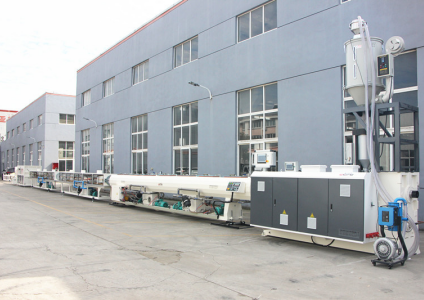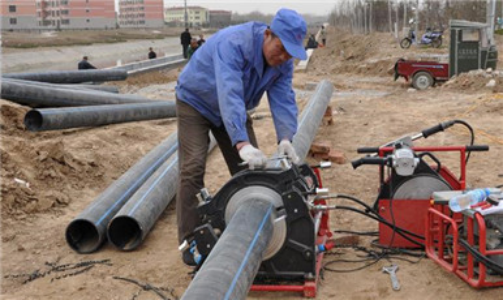Golden Far East Machinery Co.,Ltd.
Manufacturing Plastic Machinery Factory
High-Density Polyethylene (HDPE) pipes are a popular choice in various industries due to their versatility, durability, and environmental resistance. Understanding how HDPE pipes are manufactured helps us appreciate their widespread use in water supply systems, sewage, gas distribution, and even cable protection. The production process involves several carefully monitored steps to ensure quality, strength, and longevity. Below is a detailed explanation of the HDPE pipe manufacturing process, from raw material preparation to the final inspection of the product.
The manufacturing process of HDPE pipes begins with the preparation of the raw material. The key ingredient is High-Density Polyethylene resin, which is derived from petroleum. This thermoplastic polymer is preferred for its high strength-to-density ratio and excellent resistance to chemicals and environmental stress cracking.
HDPE resin comes in the form of small pellets, which are easy to transport and feed into the production process. The resin may also include additives to enhance properties such as UV resistance, color stability, or thermal performance, depending on the intended application of the pipe. These additives are mixed thoroughly with the raw HDPE resin before the manufacturing process begins.

The primary method used to manufacture HDPE pipes is extrusion. In this process, the HDPE resin is fed into a hopper, where it enters an extruder machine. The extruder consists of a rotating screw housed in a heated barrel. As the resin moves along the screw, it is subjected to increasing temperatures, causing it to melt into a viscous fluid.
During this stage, the HDPE resin is melted at temperatures typically between 180°C and 240°C. The screw in the extruder continuously mixes the molten polymer to ensure uniform heat distribution and a consistent melt. Homogenization of the molten material is critical for producing pipes with consistent wall thickness and structural integrity.
Once the HDPE is fully melted and homogenized, it is forced through a die, which gives the material the shape of a pipe. The size and shape of the die determine the diameter and wall thickness of the pipe. The pipe is extruded continuously, emerging from the die as a long, hollow tube of molten polymer.
After extrusion, the hot HDPE pipe is immediately cooled to solidify its shape. The cooling process is typically achieved using a water bath or air cooling, depending on the pipe's size and the production rate.
For most HDPE pipes, a water bath is used. The pipe is passed through a cooling tank filled with cold water, which rapidly reduces the temperature of the molten pipe, turning it into a solid, durable product. The cooling process must be carefully controlled to prevent internal stresses or warping of the pipe.
As the pipe cools, it also undergoes a calibration process to ensure that it maintains its precise dimensions. Vacuum calibration is commonly used in the water bath to stabilize the pipe's diameter and roundness. The pipe passes through a series of vacuum chambers, which apply suction to mold the pipe into its final shape and size.
Once the pipe has sufficiently cooled and solidified, it is pulled along the production line by a haul-off machine. This device grips the pipe without damaging it and pulls it at a constant speed, matching the extrusion rate.
As the pipe is drawn from the extruder, it reaches the cutting section, where automated cutters slice the pipe into predetermined lengths. These lengths can vary based on customer requirements or standard manufacturing specifications. Typical HDPE pipe lengths range from 6 meters to 12 meters, though custom sizes can be produced.
Quality control is an essential part of the HDPE pipe manufacturing process. Several tests are conducted to ensure that the pipes meet the required standards for strength, durability, and performance.
The dimensions of the pipe, including its diameter, wall thickness, and roundness, are measured at various points in the production line to ensure consistency. Pipes that do not meet the specified tolerances are rejected and recycled.
Many HDPE pipes are designed for use in high-pressure environments, such as water or gas distribution systems. To verify the pipe's strength, samples undergo pressure testing. In this test, the pipe is subjected to internal pressure far beyond what it will experience in normal use, ensuring that it will perform reliably without bursting or leaking.
A final visual inspection is carried out to detect any surface defects, such as scratches, dents, or discolorations. Pipes that pass all the tests are deemed ready for use, while those with defects are either reprocessed or scrapped.
Before the HDPE pipes are dispatched, they undergo marking and packaging.
Each pipe is marked with critical information such as the manufacturer’s name, pipe size, pressure rating, material grade, and manufacturing date. These markings are essential for ensuring traceability and compliance with industry standards.
Once marked, the pipes are bundled for shipment. They may be stacked on pallets or coiled, depending on the size and length. For smaller diameter pipes, coiling is a preferred method as it saves space during transportation. The pipes are then wrapped in protective materials to prevent damage during handling and shipping.
HDPE is a recyclable material, and any scraps or defective pipes generated during the manufacturing process are collected and reprocessed. These scraps are ground down into pellets and can be reused in the production of new pipes or other HDPE products. This recycling capability makes HDPE a sustainable option for industries that prioritize environmental responsibility.

The manufacturing of HDPE pipes is a highly controlled process that ensures the production of strong, durable, and reliable products. From raw material preparation to extrusion, cooling, and quality control, each step is critical in ensuring the pipe meets the specific demands of various industries. HDPE pipes are known for their resistance to corrosion, chemicals, and environmental factors, making them ideal for a wide range of applications. As manufacturers continue to refine the process and introduce new technologies, the demand for HDPE pipes is expected to grow even further in the coming years.